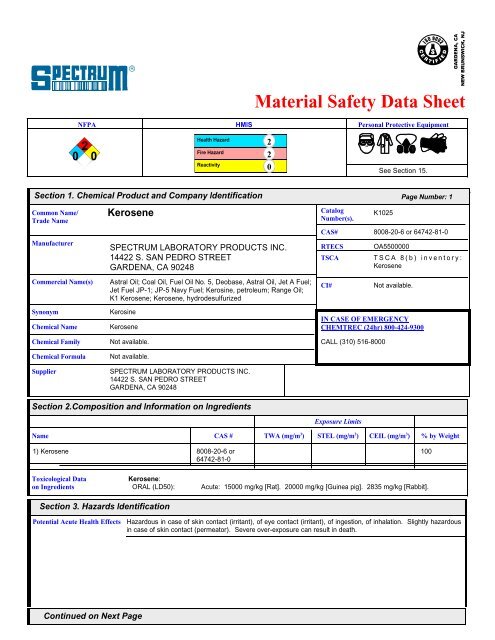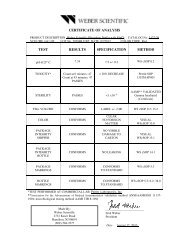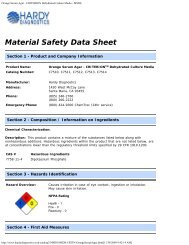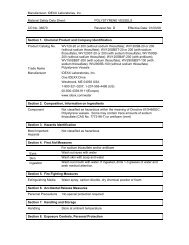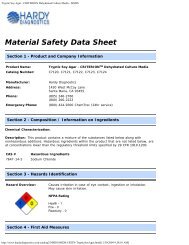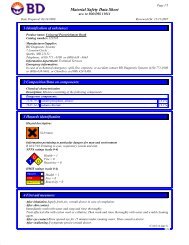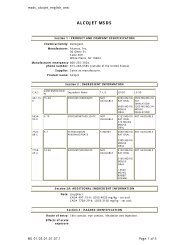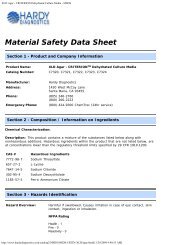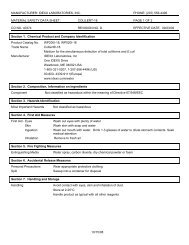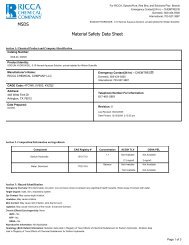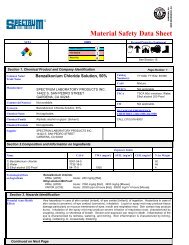Material Safety Data Sheet - Weber Scientific
Material Safety Data Sheet - Weber Scientific
Material Safety Data Sheet - Weber Scientific
You also want an ePaper? Increase the reach of your titles
YUMPU automatically turns print PDFs into web optimized ePapers that Google loves.
<strong>Material</strong> <strong>Safety</strong> <strong>Data</strong> <strong>Sheet</strong>NFPA HMIS Personal Protective Equipment20 0Health HazardFire HazardReactivity220See Section 15.Section 1. Chemical Product and Company IdentificationCommon Name/Trade NameManufacturerCommercial Name(s)SynonymChemical NameKeroseneSPECTRUM LABORATORY PRODUCTS INC.14422 S. SAN PEDRO STREETGARDENA, CA 90248Astral Oil; Coal Oil, Fuel Oil No. 5, Deobase, Astral Oil, Jet A Fuel;Jet Fuel JP-1; JP-5 Navy Fuel; Kerosine, petroleum; Range Oil;K1 Kerosene; Kerosene, hydrodesulfurizedKerosineKeroseneCatalogNumber(s).CAS#RTECSTSCACI#K10258008-20-6 or 64742-81-0OA5500000Not available.IN CASE OF EMERGENCYCHEMTREC (24hr) 800-424-9300Page Number: 1TSCA 8(b) inventory:KeroseneChemical FamilyChemical FormulaSupplierNot available.Not available.SPECTRUM LABORATORY PRODUCTS INC.14422 S. SAN PEDRO STREETGARDENA, CA 90248CALL (310) 516-8000Section 2.Composition and Information on IngredientsNameCAS #Exposure LimitsTWA (mg/m 3 ) STEL (mg/m 3 ) CEIL (mg/m 3 ) % by Weight1) Kerosene 8008-20-6 or64742-81-0100Toxicological <strong>Data</strong>on IngredientsKerosene:ORAL (LD50):Acute: 15000 mg/kg [Rat]. 20000 mg/kg [Guinea pig]. 2835 mg/kg [Rabbit].Section 3. Hazards IdentificationPotential Acute Health EffectsHazardous in case of skin contact (irritant), of eye contact (irritant), of ingestion, of inhalation. Slightly hazardousin case of skin contact (permeator). Severe over-exposure can result in death.Continued on Next Page
Kerosene Page Number: 2Potential Chronic HealthEffectsSection 4. First Aid MeasuresSlightly hazardous in case of skin contact (sensitizer).CARCINOGENIC EFFECTS: Not available.MUTAGENIC EFFECTS: Mutagenic for bacteria and/or yeast.TERATOGENIC EFFECTS: Not available.DEVELOPMENTAL TOXICITY: Not available.The substance is toxic to the nervous system.The substance may be toxic to blood, kidneys, liver, central nervous system (CNS).Repeated or prolonged exposure to the substance can produce target organs damage. Repeated exposure to ahighly toxic material may produce general deterioration of health by an accumulation in one or many humanorgans.Eye ContactSkin ContactSerious Skin ContactInhalationSerious InhalationIngestionSerious IngestionCheck for and remove any contact lenses. In case of contact, immediately flush eyes with plenty of water for atleast 15 minutes. Get medical attention.In case of contact, immediately flush skin with plenty of water. Cover the irritated skin with an emollient. Removecontaminated clothing and shoes. Wash clothing before reuse. Thoroughly clean shoes before reuse. Getmedical attention.Wash with a disinfectant soap and cover the contaminated skin with an anti-bacterial cream. Seek immediatemedical attention.If inhaled, remove to fresh air. If not breathing, give artificial respiration. If breathing is difficult, give oxygen. Getmedical attention immediately.Evacuate the victim to a safe area as soon as possible. Loosen tight clothing such as a collar, tie, belt orwaistband. If breathing is difficult, administer oxygen. If the victim is not breathing, perform mouth-to-mouthresuscitation. WARNING: It may be hazardous to the person providing aid to give mouth-to-mouth resuscitationwhen the inhaled material is toxic, infectious or corrosive. Seek immediate medical attention.If swallowed, do NOT induce vomiting. If swallowed, do not induce vomiting unless directed to do so by medicalpersonnel. Never give anything by mouth to an unconscious person. Loosen tight clothing such as a collar, tie,belt or waistband. Get medical attention immediately.Not available.Section 5. Fire and Explosion <strong>Data</strong>Flammability of the ProductAuto-Ignition TemperatureFlash PointsFlammable LimitsProducts of CombustionFire Hazards in Presence ofVarious SubstancesFlammable.210°C (410°F)CLOSED CUP: 38°C (100.4°F). (Tagliabue.)LOWER: 0.7% UPPER: 5% - 7%Not available.Flammable in presence of open flames and sparks, of heat.Explosion Hazards in Presenceof Various SubstancesRisks of explosion of the product in presence of mechanical impact: Not available.Risks of explosion of the product in presence of static discharge: Not available.Fire Fighting Mediaand InstructionsSpecial Remarks onFire HazardsSpecial Remarks on ExplosionHazardsFlammable liquid, insoluble in water.SMALL FIRE: Use DRY chemical powder.LARGE FIRE: Use water spray or fog. Cool containing vessels with water jet in order to prevent pressurebuild-up, autoignition or explosion.Not available.Not available.Continued on Next Page
Kerosene Page Number: 3Section 6. Accidental Release MeasuresSmall SpillLarge SpillAbsorb with an inert material and put the spilled material in an appropriate waste disposal.Toxic flammable liquid, insoluble or very slightly soluble in water. Poisonous liquid.Keep away from heat. Keep away from sources of ignition. Stop leak if without risk. Absorb with DRY earth,sand or other non-combustible material. Do not get water inside container. Do not touch spilled material. Usewater spray to reduce vapors. Prevent entry into sewers, basements or confined areas; dike if needed. Call forassistance on disposal.Section 7. Handling and StoragePrecautionsStorageKeep locked up.. Keep away from heat. Keep away from sources of ignition. Ground all equipment containingmaterial. Do not ingest. Do not breathe gas/fumes/ vapor/spray. Wear suitable protective clothing. In case ofinsufficient ventilation, wear suitable respiratory equipment. If ingested, seek medical advice immediately andshow the container or the label. Avoid contact with skin and eyes. Keep away from incompatibles such asoxidizing agents.Store in a segregated and approved area. Keep container in a cool, well-ventilated area. Keep container tightlyclosed and sealed until ready for use. Avoid all possible sources of ignition (spark or flame).Section 8. Exposure Controls/Personal ProtectionEngineering ControlsPersonal ProtectionPersonal Protection in Case ofa Large SpillExposure LimitsProvide exhaust ventilation or other engineering controls to keep the airborne concentrations of vapors below theirrespective threshold limit value. Ensure that eyewash stations and safety showers are proximal to thework-station location.Splash goggles. Lab coat. Vapor respirator. Be sure to use an approved/certified respirator or equivalent.Gloves.Splash goggles. Full suit. Vapor respirator. Boots. Gloves. A self contained breathing apparatus should beused to avoid inhalation of the product. Suggested protective clothing might not be sufficient; consult a specialistBEFORE handling this product.Not available.Section 9. Physical and Chemical PropertiesPhysical state and appearanceLiquid. (Oily liquid.)OdorNot available.Molecular WeightpH (1% soln/water)Not available.Not applicable.TasteColorNot available.Yellow. Clear (Light.)Boiling Point149°C (300.2°F) - 325 CMelting PointNot available.Critical TemperatureNot available.Specific Gravity0.775 - .840(Water = 1)Vapor Pressure0.1 kPa (@ 20°C)Vapor Density4.5 (Air = 1)VolatilityNot available.Odor ThresholdNot available.Water/Oil Dist. Coeff.Not available.Ionicity (in Water)Not available.Dispersion PropertiesNot available.SolubilityInsoluble in cold water, hot water.Miscible with other petroleum solventsContinued on Next Page
Kerosene Page Number: 4Section 10. Stability and Reactivity <strong>Data</strong>StabilityInstability TemperatureConditions of InstabilityIncompatibility with varioussubstancesCorrosivityThe product is stable.Not available.Heat, ignition sources (sparks, flames), incompatible materialsReactive with oxidizing agents.Not considered to be corrosive for metals and glass.Special Remarks onReactivitySpecial Remarks onCorrosivityPolymerizationNot available.Not available.Will not occur.Section 11. Toxicological InformationRoutes of EntryToxicity to AnimalsChronic Effects on HumansOther Toxic Effects onHumansSpecial Remarks onToxicity to AnimalsSpecial Remarks onChronic Effects on HumansSpecial Remarks on otherToxic Effects on HumansAbsorbed through skin. Eye contact.Acute oral toxicity (LD50): 2835 mg/kg [Rabbit].MUTAGENIC EFFECTS: Mutagenic for bacteria and/or yeast.Causes damage to the following organs: the nervous system.May cause damage to the following organs: blood, kidneys, liver, central nervous system (CNS).Hazardous in case of skin contact (irritant), of ingestion, of inhalation (lung irritant).Slightly hazardous in case of skin contact (permeator).Not available.May affect genetic material (mutagenic)Acute Potential Health Effects:Skin: Causes moderate to severe skin irritation. It can cause defatting dermatitis.Eyes: May cause eye irritation.Inhalation: May cause respiratory tract and mucous membrane irritation and a burning sensation in the chest.Because of its relatively low volatility, overexposure by inhalation is uncommon, but it can occur in poorly ventilatedareas or by inhalation of mists or aerosols. Symptoms of inhalation overexposure include central nevous system(CNS) depression (transient euphora, headache, irritability, excitement, ringing in the ears, weakness,incoordination, confusion, disorientation, drowsiness, tremor, somnolence, hallucinations, seizures, coma, death).May affect the heart (cardiac arrythmias), liver, kidneys, and respiration( asphyxia, apnea, acute pulmonaryedema, dyspnea, fibrosis, or cyanosis)Ingestion: Causes gastrointestinal tract irritation with burning sensation in mouth, esophagus, and stomach,abdominal pain, nausea, vomiting, hypermotility, diarrhea, headache, malaise. May affectrespiration/trachea/bronchi through accidental pulmonary aspiration which can cause hypoxia, chemicalpneumonitis, and noncardiogenic pulmonary edema, pulmonary hemmorrhage, coughing, breathing difficulty,acute or chronic pulmonary edema, emphysema, respiratory stimulation. It may also affect the heart(dysrrhythmias, myocardial depression, tachycardia), liver, endocrine system (pancreas - hypoglycemia),behavior/central nervous system (symptoms similar to that of inhalation).Chronic Potential Health Effects:Inhalation: Repeated or prolonged inhalation may cause respiratory tract irritation and affect behavior/centralnervous system with symptoms similar to that of acute inhalation. It may also affect the blood (changes in whiteblood cell count, changes in serum compositon, pigmented or nucleated red blood cells, leukopenia, normocyticanemia) , cardiovascular system, respiratory system (trachea, bronchi), and may cause kidney damage.Ingestion: Repeated or prolonged ingestion may affect the liver, endocrine system (adrenal gland, pancreas,spleen), and metabolism (weight loss), and blood.Skin: Repeated or prolonged skin contact may cause defatting dermatitis, erythema, and eczema-like skinlesions, drying and cracking of the skin, and possible burns.Continued on Next Page
Kerosene Page Number: 5Section 12. Ecological InformationEcotoxicityBOD5 and CODProducts of BiodegradationToxicity of the Productsof BiodegradationSpecial Remarks on theProducts of BiodegradationNot available.Not available.Possibly hazardous short term degradation products are not likely. However, long term degradation products mayarise.Not available.Not available.Section 13. Disposal ConsiderationsWaste DisposalWaste must be disposed of in accordance with federal, state and local environmentalcontrol regulations.Section 14. Transport InformationDOT ClassificationCLASS 3: Flammable liquid.Identification: Kerosene UNNA: 1223 PG: IIISpecial Provisions forTransportNot available.DOT (Pictograms)Section 15. Other Regulatory Information and PictogramsFederal and StateRegulationsCaliforniaProposition 65WarningsOther RegulationsConnecticut hazardous material survey.: KeroseneRhode Island RTK hazardous substances: KerosenePennsylvania RTK: KeroseneMassachusetts RTK: KeroseneMassachusetts spill list: KeroseneNew Jersey: KeroseneTSCA 8(b) inventory: KeroseneCalifornia prop. 65: This product contains the following ingredients for which the State of California has foundto cause cancer which would require a warning under the statute: No products were found.California prop. 65: This product contains the following ingredients for which the State of California has foundto cause birth defects which would require a warning under the statute: No products were found.OSHA: Hazardous by definition of Hazard Communication Standard (29 CFR 1910.1200).EINECS: This product is on the European Inventory of Existing Commercial Chemical Substances.Other ClassificationsWHMIS (Canada)CLASS B-3: Combustible liquid with a flash point between 37.8°C (100°F) and 93.3°C(200°F).CLASS D-2B: <strong>Material</strong> causing other toxic effects (TOXIC).DSCL (EEC)R10- Flammable.R65- Harmful: may cause lungdamage if swallowed.S23- Do not breathe gas/fumes/vapour/sprayS24- Avoid contact with skin.S62- If swallowed, do not induce vomiting: seekmedical advice immediately and show thiscontainer or label.Continued on Next Page
Kerosene Page Number: 6HMIS (U.S.A.)Health HazardFire HazardReactivityPersonal Protection220hNational Fire ProtectionAssociation (U.S.A.)Health020FlammabilityReactivitySpecific hazardWHMIS (Canada)(Pictograms)DSCL (Europe)(Pictograms)TDG (Canada)(Pictograms)3ADR (Europe)(Pictograms)Protective EquipmentGloves.Lab coat.Vapor respirator. Be sure to use anapproved/certified respirator orequivalent. Wear appropriate respiratorwhen ventilation is inadequate.Splash goggles.Continued on Next Page
Kerosene Page Number: 7Section 16. Other InformationMSDS CodeReferencesOther SpecialConsiderationsK3050Not available.Not available.Validated by Sonia Owen on 8/11/2006.Verified by Sonia Owen.Printed 9/12/2006.CALL (310) 516-8000Notice to ReaderAll chemicals may pose unknown hazards and should be used with caution. This <strong>Material</strong> <strong>Safety</strong> <strong>Data</strong> <strong>Sheet</strong> (MSDS) applies only to the material as packaged. If this product iscombined with other materials, deteriorates, or becomes contaminated, it may pose hazards not mentioned in this MSDS. It shall be the user's responsibility to develop propermethods of handling and personal protection based on the actual conditions of use. While this MSDS is based on technical data judged to be reliable, Spectrum Quality Products,Inc. assumes no responsibility for the completeness or accuracy of the information contained herein.
W. R. GRACEMATERIAL SAFETY DATA SHEETProduct Name: MicroWhite® Vermiculite DispersionMSDS ID Number: Z-01666 MSDS Date: 09/19/2006SECTION 1 - CHEMICAL PRODUCT AND COMPANY IDENTIFICATIONProduct Name:MicroWhite® Vermiculite DispersionMSDS Number: Z-01666Cancelled MSDS Number: Z-01639MSDS Date: 09/19/2006Chemical Family Name:Chemically Delaminated Vermiculite (from South Carolina OreConcentrate) DispersionProduct Use:High Temperature Coating, Filler, BinderChemical Formula:Mixture-NACAS # (Chemical Abstracts Service Mixture-NANumber):Manufactured by:W.R.Grace & Co.-Conn. Grace Canada, Inc.62 Whittemore Avenue 294 Clements Road WestCambridge, MA 02140 Ajax, Ontario L1S 3C6In Case of Emergency Call:In USA: (617) 876-1400 In Canada: (905) 683-8561SECTION 2 - COMPOSITION/INFORMATION ON INGREDIENTSIngredient CAS# Percent (max)Quartz 014808-60-7 < 1Titanium dioxide 013463-67-7 1-10Vermiculite Dispersion 110638-71-6 10-25SECTION 3 - HAZARDS IDENTIFICATIONEmergency Overview:Caution!Causes eye irritation.Inhalation causes respiratory irritation.Causes digestive tract irritation if ingested.HMIS Rating:Health: 1Flammability: 0Reactivity: 0Personal Protective Equipment: B (See Section 8)Potential Health Effects:Inhalation: Overexposure is not likely to occur unless specific use generates dust, vapors, or mist.If inhaled, causes respiratory tract irritation.Eye Contact: Eye contact causes irritation.Prolonged eye contact can result in tissue damage.Skin Contact: Acute skin contact is not expected to result in adverse effects.Prolonged skin contact can result in irritation.Skin Absorption: Not expected to be harmful if absorbed through the skin.Ingestion: If ingested, causes irritation to the linings of the mouth, esophagus, and stomach.Effects include: irritation or upset stomach.SECTION 4 - FIRST AID MEASURES:Skin Contact: Wash with soap and water.If discomfort or irritation persists, consult a physician.Remove contaminated clothing and wash before reuse.Eye Contact: Flush eyes with water for at least 15 minutes while holding eyelids open.If discomfort or irritation persists, consult a physician.Ingestion: Give large quantities of water to drink for dilution effect. If gastrointestinal symptomsdevelop, consult a physician. Never give anything by mouth to an unconscious person.Page 1 of 5
W. R. GRACEMATERIAL SAFETY DATA SHEETProduct Name: MicroWhite® Vermiculite DispersionMSDS ID Number: Z-01666 MSDS Date: 09/19/2006Inhalation: If symptoms develop, get fresh air. If symptoms persist, consult a physician.If breathing has stopped, give artificial respiration then oxygen if needed.SECTION 5 - FIRE AND EXPLOSION HAZARD DATAFlash Point:Not ApplicableFlash Point Method:Not ApplicableLower Explosion Limit:Not AvailableUpper Explosion Limit:Not AvailableAuto-Ignition Temperature:Not AvailableNFPA Rating:Health: 1Flammability: 0Reactivity: 0Extinguishing Media: Not Applicable. Product will not burn.Special Fire Fighting Procedures: NoneNo special procedures specific to this product.Unusual Fire and Explosion Hazards: None unless noted below.SECTION 6 - ACCIDENTAL RELEASE MEASURES:Spills/Leaks: Use proper personal protective equipment. Collect liquid or absorb liquid with an inert,noncombustible material and remove for disposalSECTION 7 - HANDLING AND STORAGEPrecautionary Measures:Avoid contact with eyes, skin and clothing.Do not take internally.Practice good personal hygiene to avoid ingestion.Use only with adequate ventilation.Wash clothing before reuse.Provide respiratory protection if needed.FOR PROFESSIONAL USE ONLY. KEEP OUT OF CHILDREN'S REACH.SECTION 8 - EXPOSURE CONTROLS AND PERSONAL PROTECTIVE EQUIPMENTEXPOSURE GUIDELINES (US)Ingredient ACGIH TLV OSHA PEL OtherTWA STEL Ceiling TWA STEL CeilingTitanium dioxide 10 mg/m3 TWA - - 10 mg/m3 TWA - -(total dust)Vermiculite Dispersion - - - - - -Quartz0.05 mg/m3 TWA(respirable fraction)- - 0.1 mg/m3 TWA(respirable dust)- -Respirable Quartz (Crystalline silica) and Titanium dioxide can result in lung disease (i.e. silicosis and or lungcancer). However, due to the physical nature of this product (liquid) exposures are not expected unlessproduct dries, is abraded and airborne dust is created.EXPOSURE GUIDELINES (CANADA)Employers should consult local Provincial regulatory limits for exposure guidelines which may vary locally.Engineering Controls:Not generally required.Personal Protective Equipment:Respiratory Protection: Respiratory protection may be desirable if dust is created in handling and isrequired at or above the Permissible Exposure Limit (PEL) for nuisance particulates.Page 2 of 5
W. R. GRACEMATERIAL SAFETY DATA SHEETProduct Name: MicroWhite® Vermiculite DispersionMSDS ID Number: Z-01666 MSDS Date: 09/19/2006Skin Protection: Gloves are recommended.Eye Protection: <strong>Safety</strong> glasses or goggles should be worn.Work/Hygienic Practices:. Use good personal hygiene practices.This product is a chemically delaminated vermiculite dispersed in 80-95% water. The vermiculiteused in this product is a naturally-occuring mineral mined in South Carolina which can containtremolite in the ore body. Except for trace amounts, the tremolite, which is predominantely nonfiberous,is removed from the vermiculite during processing.In an effort to assure that this product is high purity, WR-Grace & Co. has retained the services of anoutside independent laboratory. This laboratory has analyzed samples using a state-of-the-artelectron microscope. Using this technique, no fiberous tremolite has been detected.Quartz (Crystalline silica) is a naturally occurring mineral that is contained in materials that are minedfrom the earth's surface such as sand, limestone, clay and gypsum (calcium sulfate). Total quartz is avalue usually representing the combined fraction of large non-respirable sized particles and ofresprable sized particles (less than ten micros in acrodynamic diameter). It is only the respirablesized fraction of total quartz that is recognized as hazardous by professionals in the field ofOccupational Health and by most regulatory agencies.Due to the physical nature of this product, (liquid) Quartz (Crystalline silica) exposures are notexpected.SECTION 9 - PHYSICAL AND CHEMICAL PROPERTIESPhysical State:LiquidAppearance/Odor:Aqueous dispersion, white, no appreciable odorOdor Threshold: (ppm)Not DeterminedpH: 6.5 - 8.5Vapor Pressure: (Mm Hg)20 @ 22 deg. CVapor Density: (Air = 1)1.18 @ 22 deg. CSolubility In Water:Miscible with waterSpecific Gravity: (Water = 1)Not AvailableEvaporation Rate: (Butyl Acetate = 1) UnknownBoiling Point: 212 deg. F (100 deg. C)Viscosity:UnknownBulk Density: (Pounds/CubicNot ApplicableFoot)(Pcf)% Volatiles (gr/L): (70°F) (21°C) 80 - 95 % (As water)SECTION 10 - STABILITY AND REACTIVITYChemical Stability:StableConditions To Avoid:None known for this product.Hazardous Polymerization: Will not polymerize.Hazardous Decomposition None known for this product.Products:SECTION 11 - TOXICOLOGICAL INFORMATIONIngredient(No data unless listed.) CAS Number LD50 and LC50Carcinogenicity:IngredientIARCGroup 1IARCGroup 2AIARCGroup 2BNTPKnownNTPSuspectTitanium dioxide No No Yes No No NoVermiculite Dispersion No No No No No NoQuartz Yes No No No No YesRespirable Quartz (Crystalline silica) and Titanium dioxide can result in lung disease (i.e. silicosis and or lungcancer). However, due to the physical nature of this product (liquid) exposures are not expected unlessproduct dries, is abraded and airborne dust is created.Mutagenicity:Not applicable.Teratogenicity:Not applicable.Reproductive Toxicity:Not applicable.OSHAPage 3 of 5
W. R. GRACEMATERIAL SAFETY DATA SHEETProduct Name: MicroWhite® Vermiculite DispersionMSDS ID Number: Z-01666 MSDS Date: 09/19/2006SECTION 12 - ECOLOGICAL INFORMATIONEnvironmental Fate:Ecotoxicity:No data available for product.No data available for product.SECTION 13 - DISPOSAL CONSIDERATIONSWaste Disposal Procedures: Consult all regulations (federal, state, provincial, local) or a qualifiedwaste disposal firm when characterizing waste for disposal. According to EPA (40 CFR § 261),waste of this product is not defined as hazardous. Dispose of waste in accordance with all applicableregulations.SECTION 14 - TRANSPORTATION INFORMATIONProper Shipping Name:Not ApplicableUN/NA Number:Not ApplicableDomestic Hazard Class:NonhazardousSurface Freight Classification: Silicate Solution Class 55Label/Placard Required:Not ApplicableSECTION 15 - REGULATORY INFORMATIONREGULATORY CHEMICAL LISTS:CERCLA (Comprehensive Response Compensation and Liability Act):(None present unless listed below)Chemical Name CAS # Wt % CERCLA RQSARA Title III (Superfund Amendments and Reauthorization Act)SARA Section 312/Tier I & II Hazard Categories:Health Immediate (acute)NoHealth Delayed (chronic)NoFlammableNoReactiveNoPressureNo302 Reportable Ingredients (Identification Threshold 1%.):Chemical Name CAS # Wt % SARA 302 TPQ313 Reportable Ingredients (Chemicals present below reporting threshold are exempt):Chemical Name CAS # Wt %National Volatile Organic Compound Emission Standards For Architectural Coatings:Volatile Organic Content: (gr/L) Not ApplicableWHMIS Classification(s):D2 BThis product has been classified in accordance with the hazard criteria of the Controlled ProductsRegulations (CPR). This MSDS contains all the information required by the CPR.State Regulatory Information:California Proposition 65: This product contains substances known to the state of California to causecancer, birth defects or other reproductive harm.Massachusetts Hazardous Substance List(Identification threshold 0.001%(1ppm)):Chemical Name CAS # Wt %New Jersey Hazardous Substance List(Identification threshold (0.1%)):Chemical Name CAS # Wt %Page 4 of 5
W. R. GRACEMATERIAL SAFETY DATA SHEETProduct Name: MicroWhite® Vermiculite DispersionMSDS ID Number: Z-01666 MSDS Date: 09/19/2006Pennsylvania Hazardous Substance List(Identification threshold 0.01%):Chemical Name CAS # Wt %CHEMICAL INVENTORY STATUS:All chemicals in this product are listed or exempt from listing in the following countries:US CANADA EUROPE AUSTRALIA JAPAN KOREA PHILIPPINESTSCA DSL NDSL EINECS/ELINCS AICS ENCS ECL PICCSYes No Yes Yes No No No NoSECTION 16 - OTHER INFORMATIONNon-Hazardous Ingredient Disclosure:Chemical NameCAS NumberPrepared by:EH&S DepartmentApproved by:EH&S DepartmentApproved Date: 09/19/2006Disclaimer:"The data included herein are presented in accordance with various environment, health and safetyregulations. It is the responsibility of a recipient of the data to remain currently informed on chemical hazardinformation, to design and update its own program and to comply with all national, federal, state and locallaws and regulations applicable to safety, occupational health, right-to-know and environmental protection."Page 5 of 5


